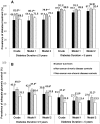Comparison of diabetes management status between cancer survivors and the general population: results from a Korean population-based survey
- PMID: 25313795
- PMCID: PMC4196996
- DOI: 10.1371/journal.pone.0110412
Comparison of diabetes management status between cancer survivors and the general population: results from a Korean population-based survey
Abstract
Purpose: This study aimed to determine and compare the prevalences of diabetes awareness, treatment, and adequate glycemic control among cancer survivors in a Korean population and two non-cancer control groups, comprising individuals without a history of cancer but with other chronic diseases (non-cancer, chronic disease controls) and individuals without a history of cancer or any other chronic disease (non-cancer, non-chronic disease controls).
Methods: We analyzed data from 2,660 subjects with prevalent diabetes (aged ≥30 years), who had participated in the 2007-2011 Korea National Health and Nutrition Examination Survey. Awareness was defined as a subject having been diagnosed with diabetes by a clinician. Treatment was defined as a subject who was taking anti-diabetic medicine. Adequate glycemic control was defined as a hemoglobin A1c level of <7%. Multivariable logistic regression and predictive margins were used to evaluate whether awareness, treatment, or adequate glycemic control differed among cancer survivors and the two non-cancer control groups.
Results: Cancer survivors had greater awareness compared with the non-cancer, chronic disease and non-cancer, non-chronic disease control groups (85.1%, 80.4%, and 60.4%, respectively). Although the prevalences of treatment and adequate glycemic control were higher for survivors compared with the non-cancer, non-chronic disease controls, they were lower compared with the non-cancer, chronic disease controls. The prevalence of diabetes treatment was 67.5% for cancer survivors, 69.5% for non-cancer, chronic disease controls, and 46.7% for non-cancer, non-chronic disease controls; the prevalences of adequate glycemic control in these three groups were 31.7%, 34.6%, and 17.8%, respectively.
Conclusions: Cancer survivors were less likely than the non-cancer chronic disease subjects to receive diabetes management and to achieve adequate glycemic targets. Special attention and education are required to ensure that this population receives optimal diabetes care, and the systematic roles for primary care and specialist physicians need to be determined.
Conflict of interest statement
Figures


Similar articles
-
Prevalence, awareness, control, and treatment of hypertension and diabetes in korean cancer survivors: a cross-sectional analysis of the fourth and fifth Korea national health and nutrition examination surveys.Asian Pac J Cancer Prev. 2013;14(12):7685-92. doi: 10.7314/apjcp.2013.14.12.7685. Asian Pac J Cancer Prev. 2013. PMID: 24460354
-
Comparison of physical and mental health status between cancer survivors and the general population: a Korean population-based survey (KNHANES II-IV).Support Care Cancer. 2013 Dec;21(12):3471-81. doi: 10.1007/s00520-013-1939-8. Epub 2013 Aug 18. Support Care Cancer. 2013. PMID: 23955095
-
Trends in the prevalence and management of diabetes in Korea: 2007-2017.Epidemiol Health. 2019;41:e2019029. doi: 10.4178/epih.e2019029. Epub 2019 Jul 4. Epidemiol Health. 2019. PMID: 31319658 Free PMC article.
-
Diabetes Fact Sheets in Korea 2024.Diabetes Metab J. 2025 Jan;49(1):24-33. doi: 10.4093/dmj.2024.0818. Epub 2025 Jan 1. Diabetes Metab J. 2025. PMID: 39828976 Free PMC article.
-
Current status of managing diabetes mellitus in Korea.Korean J Intern Med. 2016 Sep;31(5):845-50. doi: 10.3904/kjim.2016.253. Epub 2016 Sep 1. Korean J Intern Med. 2016. PMID: 27604796 Free PMC article. Review.
Cited by
-
Comparative Study of Diabetes Knowledge, Attitudes, Family Support, Self-efficacy, and Self-management Behaviors Between Cancer Survivors With Diabetes and Diabetes Patients Without Cancer.Cancer Nurs. 2025 Sep-Oct 01;48(5):E313-E320. doi: 10.1097/NCC.0000000000001351. Epub 2024 Apr 12. Cancer Nurs. 2025. PMID: 40838966 Free PMC article.
-
Quality of diabetes care in cancer: a systematic review.Int J Qual Health Care. 2019 Mar 1;31(2):75-88. doi: 10.1093/intqhc/mzy124. Int J Qual Health Care. 2019. PMID: 29912446 Free PMC article.
-
Metabolic comorbidities and medical institution utilization among breast cancer survivors: a national population-based study.Korean J Intern Med. 2020 Mar;35(2):421-428. doi: 10.3904/kjim.2018.172. Epub 2019 Sep 5. Korean J Intern Med. 2020. PMID: 31480826 Free PMC article.
-
The impact of cancer on diabetes outcomes.BMC Endocr Disord. 2019 Jun 11;19(1):60. doi: 10.1186/s12902-019-0377-0. BMC Endocr Disord. 2019. PMID: 31185995 Free PMC article.
-
Association of dietary sodium intake with impaired fasting glucose in adult cancer survivors: A population-based cross-sectional study.PLoS One. 2023 May 25;18(5):e0286346. doi: 10.1371/journal.pone.0286346. eCollection 2023. PLoS One. 2023. PMID: 37228155 Free PMC article.
References
-
- Siegel R, DeSantis C, Virgo K, Stein K, Mariotto A, et al. (2012) Cancer treatment and survivorship statistics, 2012. CA Cancer J Clin 62: 220–241. - PubMed
-
- Coughlin SS, Calle EE, Teras LR, Petrelli J, Thun MJ (2004) Diabetes Mellitus as a Predictor of Cancer Mortality in a Large Cohort of US Adults. Am J Epidemiol 159: 1160–1167. - PubMed
-
- Jee S, Ohrr H, Sull J, Yun J, Ji M, et al. (2005) Fasting serum glucose level and cancer risk in korean men and women. JAMA 293: 194–202. - PubMed
-
- Lipscombe L, Goodwin P, Zinman B, McLaughlin J, Hux J (2008) The impact of diabetes on survival following breast cancer. Breast Cancer Res Treat 109: 389–395. - PubMed
Publication types
MeSH terms
LinkOut - more resources
Full Text Sources
Other Literature Sources
Medical

